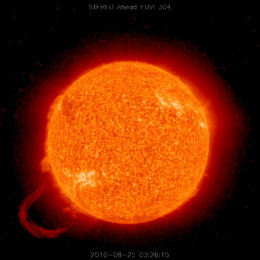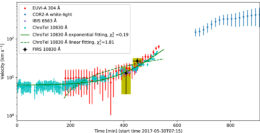On May 30, 2017, a tendril of twisted plasma fought the Sun’s gravitational pull and escaped into the solar system. What can space- and ground-based observations tell us about this event?
A Filament by Any Other Name

A solar prominence extends from the Sun’s surface in the lower left quadrant of this image. If this prominence were viewed against the Sun’s disk, the relatively cool plasma would appear dark against the solar surface. [NASA/STEREO]
Sometimes, filaments explode into space just hours after they form, often accompanied by other types of solar outbursts like flares or coronal mass ejections. On other occasions, they can linger quietly for days or months before erupting or slowly sinking back toward the Sun’s surface. Today’s article analyzes an extremely long solar filament that loitered for a week before erupting.

Evolution of the filament’s line-of-sight velocity over time. Several hours before the eruption (left panel), the filament’s velocity was close to zero. As the eruption progressed (center and right panels), the filament’s outward velocity increased. Click to enlarge. [Wang et al. 2022]
From Quiescent to Eruptive
A team led by Shuo Wang (New Mexico State University) studied the evolution of a 500,000-kilometer-long solar filament that erupted from the Sun in May 2017. Wang and collaborators analyzed spectra and images from telescopes on Earth and in space to understand how the velocity of the filament changed in the hours leading up to its eruption. Understanding how the velocity of an erupting filament evolves over time is important for discerning the mechanism that caused it to erupt as well as predicting when an Earth-directed eruption might hit us.
The team found that the filament didn’t launch into space from a complete standstill, but rather had a (relatively) low upward velocity of 6.3 kilometers per second in the hours before the eruption. Rather than being a coherent structure, the filament contained multiple discrete threads of plasma, which showed their own velocity evolution. As the eruption drew nearer, the velocity distribution of these threads became heavily skewed toward higher velocities. Finally, the filament broke free of the Sun with a velocity of 430 km/s — fast enough to reach Earth’s orbit in just four days.
Launching an Investigation

Velocity of the filament over time, as derived from the multiple data sets analyzed in this work. The solid and dashed green lines show the exponential and linear fits to the data, respectively. Click to enlarge. [Adapted from Wang et al. 2022]
The question of what caused the filament’s initial, low-velocity motion away from the Sun may be harder to answer since there is a gap in the observations between the filament’s quiescent phase, when its velocity was zero, and when it began to move upward at 6.3 km/s. Other events have also shown slow upward motion hours before the eruption, so further analysis of other eruptive solar filaments may help us understand why some filaments erupt while others sink back to the surface unperturbed.
Bonus
Check out this video from the authors’ article, which shows the evolution of the filament over the course of 19 hours from two different angles.
Citation
“Velocities of an Erupting Filament,” Shuo Wang et al 2022 ApJ 926 18. doi:10.3847/1538-4357/ac3a04
